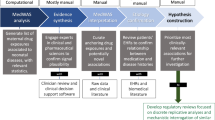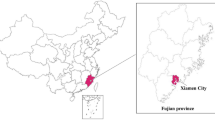Abstract
It is a major clinical and public health problem that there is no clear strategy as to how we best make use of information obtained when pregnant women take drugs. For this reason, some pregnant women are not treated as they should be and some are given drugs they should not use. We suggest a monitoring system that combines some of the available datasets in Europe. Using these sources as a starting point, one can develop a system that has sufficient power to detect even rare diseases like congenital malformations and sufficient diversity to detect several possible outcomes from spontaneous abortions to childhood disorders. We also suggest that case-crossover designs should be used in case-control monitoring systems that carry a high risk of recall bias. These considerations are based upon our results from a European Union-funded concerted action called EuroMaP (Medicine and Pregnancy).
Similar content being viewed by others
References
Bonati M, Bortolus R, Marchetti F, et al. Drug use in pregnancy: an overview of epidemiological (drug utilization) studies. Eur J Clin Pharmacol 1990; 38: 325–8
Marchetti F, Romero M, Bonati M, et al. Use of psychotropic drugs during pregnancy: a report of the international cooperative drug use in pregnancy (DUP) study. Collaborative Group on Drug Use in Pregnancy (CGDUP). Eur J Clin Pharmacol 1993; 45: 495–501
Lenz W, Knapp K. Thalidomide embryopathy. Arch Environ Health. 1962; 5: 100–5
McBride WG. Thalidomide and congenital abnormalities [letter]. Lancet 1961; ii: 1358
Koren G, Pastuszak A. Drugs in pregnancy.N Engl J Med. 1998; 338: 1128–37
Rubin P. Drug treatment during pregnancy. BMJ 1998; 317: 1503–6
Olsen J. Prenatal exposures and long term health effects. Epidemiol Rev 2000; 22: 76–8
Giusti RM, Iwamoto K, Hatch EE. Diethylstilbestrol revisited: a review of the long-term health effects. Ann Intern Med 1995; 122(10): 778–88
Olsen J, Melbye M, Olsen SF, et al. The Danish national birth cohort: its background, structure and aim. Scand J Public Health 2001; 29: 300–7
Heinonen OP, Slone D, Shapiro S. The women, their offspring, and the malformations. In: Birth defects and drugs in pregnancy. Littleton (MA): Publishing Sciences Group, 1977: 30–3
Olsen J. Options in making use of pregnancy history in planning and analysing studies of reproductive failure. J Epidemiol Community Health 1994; 48: 171–4
Frank L. When an entire country is a cohort. Science 2000; 287: 2398–9
Carroli G, Villar J, Piaggio G, et al. WHO systematic review of randomised controlled trials of routine antenatal care. Lancet 2001; 357(9268): 1565–70
Källén B. Delivery outcome after the use of acid-suppressing drugs in early pregnancy with special reference to omeprazole. Br J Obstet Gynaecol 1998; 105: 877–81
Cnattingius S, Ericson A, Gunnarskog J, et al. A quality study of a medical birth registry. Scand J Soc Med 1990; 18: 143–8
Kallen B, Lygner PE. Delivery outcome in women who used drugs for migraine during pregnancy with special reference to sumatriptan. Headache 2001; 41(4): 351–6
Källén B, Rydhström H, Åberg A. Congenital malformations after the use of inhaled budesonide in early pregnancy. Obstet Gynecol 1999; 93: 392–5
Ericson A, Källén B, Wiholm B-E. Delivery outcome after the use of antidepressants in early pregnancy. Eur J Clin Pharmacol 1999; 55: 503–8
Bergman U. Pharmacoepidemiological perspectives. J Clin Epidemiol 1992; 45: 313–7
Calle EE, Khoury MJ. Completeness of the discharge diagnoses as a measure of birth defects recorded in the hospital birth record.Am J Epidemiol 1991; 134: 69–77
Olesen C, Steffensen FH, Sørensen HT, et al. Pregnancy outcome following prescription for Sumatriptan. Headache 2000; 40: 20–4
Steffensen FH, Nielsen GL, Sørensen HT, et al. Pregnancy outcome with ACE-inhibitor use in early pregnancy [letter]. Lancet 1998; 351: 596
de Vries CS, de Walle HEK, Cornel MC, et al. Registration of drug use in a birth defect monitoring system: a priority worthy of emphasis! Int J Risk Saf 1993; 4: 27–34
Lau HS, deBoer A, Beuning KS, et al. Validation of pharmacy records in drug exposure assessment. J Clin Epidemiol 1997; 50: 619–25
Jick H, Holmes LB, Hunter JR, et al. First-trimester drug use and congenital disorders. JAMA 1981; 246: 343–6
Stoler JM. Prevalence and etiology of birth defects. In: Prenatal care. McCormick MC, editor. Cambridge: Cambridge University Press, 1999
Czeizel AE, Intödy ZS, Modell B. What proportion of congenital abnormalities can be prevented? BMJ 1993; 306: 499–503
Czeizel AE. Epidemiological studies of congenital abnormalities in Hungary. In: Kalter H, editor. Issues and reviews in teratology. Dordrecht: Kluwer Academic Publishers, 2000: 85–124
Czeizel AE, Ráez J. Evaluation of drug intake during pregnancy in the Hungarian case-control surveillance of congenital anomalies. Teratology 1990; 42: 505–12
Czeizel AE. The first 25 years of the Hungarian congenital abnormality registry. Teratology 1997; 55: 299–305
Mitchell AA, Rosenberg L, Shapiro S, et al. Birth defects related to Bendectin use in pregnancy. JAMA 1981; 245: 2311–4
Bar-Oz B, Moretti ME, Mareels G, et al. Reporting bias in retrospective ascertainment of drug-induced embryopathy. Lancet 1999; 354: 1700–1
Rockenbauer M, Olsen J, Czeizel AE, et al. Recall bias in a case-control surveillance system on the use of medicine during pregnancy. Epidemiology 2001; 12: 461–6
de Jong-van den berg LTW, Feenstra N, Sørensen HT, et al. Improvement of drug exposure data in a registration of congenital anomalies. Teratology 1999; 60: 33–6
de Vries CS, de Walle HEK, Cornel MC, et al. Registration of drug use in a birth defect monitoring system: a priority worthy of emphasis! Int J Risk Saf Med 1993; 4: 27–34
de Jong-van den berg LTW, Waardenburg CM, Haaijer-Ruskamp FM, et al. Drug use in pregnancy: a comparative appraisal of data collecting methods. Eur J Clin Pharmacol 1993; 45: 9–14
Hansen D, Lou HC, Olsen J. Serious life events and congenital malformations: a national study with a complete follow-up. Lancet 2000; 356: 875–80
Olsen J. Calculating risk ratios for spontaneous abortions: the problem of induced abortions. Int J Epidemiol 1984; 13: 347–9
Garne E, Bergman U. Benzodiazepine use in pregnancy and major malformations or oral clefts: induced abortions should be included [letter]. BMJ 1999; 319: 918
Greenland S. Confounding and exposure trends in case-crossover and case-time-control designs. Epidemiology 1996; 7: 231–9
Suissa S. The case-time-control design: further assumptions and conditions. Epidemiology 1998; 9: 441–5
Reinisch JM, Sanders SA, Mortensen EL, et al. In utero exposure to phenobarbital and intelligence deficits in adult men. JAMA 1995; 274: 1518–25
Grisso JA, Carson JL, Feldman HI, et al. Epidemiological pit-falls using Medicaid data in reproductive health research. J Matern Fetal Med 1997; 6(4): 230–6
Rosa F. Databases in the assessment of the effects of drugs during pregnancy. J Allergy Clin Immunol 1999; 103(2 Pt 2): S360–1
Jick SS. Pregnancy outcomes after maternal exposure to fluconazole. Pharmacotherapy; 19(2): 221–2
Bar Oz B, Hackman R, Einarson T, et al. Pregnancy outcome after cyclosporine therapy during pregnancy: a meta-analysis. Transplantation 2001; 71(8): 1051–5
Vargas FR, Schuler-Faccini L, Brunoni D, et al. Prenatal exposure to misoprostol and vascular disruption defects: a case-control study. Am J Med Genet 2000; 95(4): 302–6
Hernandez-Diaz S, Werler MM, Walker AM, et al. Folic acid antagonists during pregnancy and the risk of birth defects. N Engl J Med 2000; 343(22): 1608–14
Ruigomez A, Garcia Rodriguez LA, Cattaruzzi C, et al. Use of cimetidine, omeprazole, and ranitidine in pregnant women and pregnancy outcomes. Am J Epidemiol 1999; 150(5): 476–81
Öhman B, Lyrvall H, Törnqvist E, et al. Clinical pharmacology and the provision of drug information. Eur J Clin Pharmacol 1992; 42: 563–8
Källén B. Drugs in pregnancy: the dilemma of labeling. Drug Inf J 1999; 33: 1135–43
Brent RL. Computer program for searching the biomedical literature in teratology, developmental biology, and reproductive biology. Teratology 1982; 25(3): 273–5
Mastroiacovo P, Serafini M, Pagano M, et al. The ‘Telefono Rosso’: a service for the prevention of birth defects and for the evaluation of teratogenic risk. Ann Ist Super Sanita 1993; 29(1): 115–20
Acknowledgements
This study was supported by the EuroMaP concerted action in the Biomed 2 work programme, contract no.BMH4 CT97-2430. Corinne S. de Vries has been funded by a Wellcome Trust Travelling Research Fellowship, grant no. 557509/Z/99/Z. The activities of the Danish Epidemiology Science Centre are financed by a grant from the Danish National Research Foundation.
Author information
Authors and Affiliations
Corresponding author
Rights and permissions
About this article
Cite this article
Olsen, J., Czeizel, A., Sørensen, H.T. et al. How Do We Best Detect Toxic Effects of Drugs Taken During Pregnancy?. Drug-Safety 25, 21–32 (2002). https://doi.org/10.2165/00002018-200225010-00003
Published:
Issue Date:
DOI: https://doi.org/10.2165/00002018-200225010-00003




